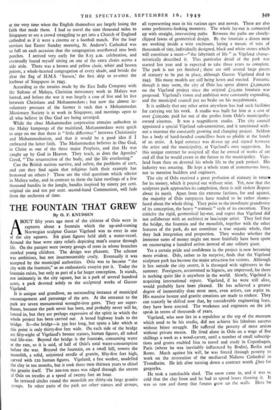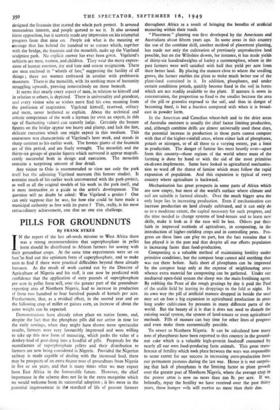THE FOUNTAIN THAT GREW
By 0. F. KNUDSEN
BOUT fifty years ago most of the citizens of Oslo were in
raptures about a fountain which the up-and-coming Norwegian sculptor Gustav Vigeland was to erect in one of the city squares. Six giant figures held aloft a water-vessel. Around the base were sixty reliefs depicting man's course through life. On the parapet were twenty groups of trees in whose branches crawled young children. The design was pleasant. The scheme was ambitious, but not insurmountably costly. Eventually it was accepted by the municipal authorities. Oslo was to become " the city with the fountain," as an enthusiastic essayist put it. Today the fountain exists, but only as part of a far huger conception. It stands, not intimately in the city square, but in a park of several hundred acres, a park devoted solely to the sculptural works of Gustav Vigeland.
It is unique and grandiose, an outstanding instance of municipal encouragement and patronage of the arts. At the entrance to the park are seven monumental wrought-iron gates. They are super- fluous, because the park never has been, and probably never will be, fenced in, but they are perhaps expressive of the spirit in which the whole project has been carried out. A broad highway leads to the bridge. It—the bridge—is 350 feet long, but spans a lake which at this point is only thirty-five feet widc. On each side of the bridge arc fifty-eight of Vigeland's bronze statues, human figures, all naked and life-size. Beyond the bridge is the fountain, consuming water at the rate, so it is said, of half of Oslo's total water-consumption before the war. Beyond the fountain, on a small hill, towers the monolith, a solid, unjointed needle of granite, fifty-five feet high, carved with no human figures. Vigeland, a fast worker, modelled the clay in ten months, but it took three men thirteen years to chisel the granite itself. The goo-ton mass was edged through the streets of Oslo on trestles at a speed of twenty feet an hour.
In terraced circles round the monolith are thirty-six large granite iroups. In other parts of the park are other statues and groups, all representing man in his various ages and moods. There are also some prehistoric-looking monsters. The whole lay-out is connected up with straight, intersecting paths Between the paths arc closely- clipped lawns of geometrical design. By the fountain a dozen men are working inside a wire enclosure, laying a mosaic of tens of thousands of tiny, individually designed, black and white stones which will constitute a maze—" the labyrinth of life " as Vigeland charac- teristically described it. This particular detail of the park was started last year and is expected to take three years to complete.
The park Is not yet finished ; there are still several large pieces of statuary to be put in place, although Gustav Vigeland died in 1943. His many models are still being hewn and erected. Fantastic though it may seem, the city of Oslo has spent almost £1,000,000 on the Vigeland project since the original £15,000 fountain was proposed. Vigeland's vision and ambition were constantly expanding, and the municipal council put no brake on his megalomania.
It is unlikely that any other artist anywhere has had such facilities for carrying out his work. A studio was built for him at a cost of over £too,000, paid for out of the profits from Oslo's municipally- owned cinemas. It was a magnificent studio. The city council appointed a special Vigcland sub-committee, and it sanctioned with- out a murmur the constantly growing and changing project. Seldom has a body of hard-headed councillors been so pliable at the hands of an artist. A legal contract was drawn up and signed between the artist and the municipality, at Vigeland's own suggestion. In this unique contract he assigned all that he owned of works of art and all that he would create in the future to the municipality. Vige- land from then on devoted his whole life to the park project. His industry was amazing. He kept a whole team of stonemasons busy, not to mention builders and engineers.
The city of Oslo received a great profusion of statuary in return, for its money, which it poured out without stint. Yet, now that the
sculpture park approaches its completion, there is still violent dispute about its merit. Apart from the extreme factions, for and against, the majority of Oslo ratepayers have tended to be rather shame- faced about the whole thing. They point to the inordinate grandiosity of its conception, the heavy " teutonic " style of its execution. They criticise the rigid, geometrical lay-out, and regret that Vigeland did not collaborate with an architect or landscape artist. They feel that the bridge, the fountain and the monolith, together with the other features of the park, do not constitute a true organic whole, that they lack integration and proportion. They wonder whether the immense sums of money might not more fruitfully have been spent on encouraging a hundred artists instead of one solitary giant.
Yet a certain pride and confidence in the project is now becoming more evident. Oslo, rather to its surprise, finds that the Vigeland sculpture park has become the major attraction for visitors. Although it lies outside the city centre, it is thronged with sightseers in the summer. Foreigners, accustomed to bigness, are impressed, for there is nothing quite like it anywhere in the world. Slowly, Vigeland is acquiring international repute. Vigeland, if he were still alive, would probably have been pleased. He has achieved a greater degree of immortality than most men, even artists, can aspire to. His massive bronze and granite creations are made to endure. They can scarcely be shifted now that, by considerable engineering feats, they have been erected. The workmen and engineers on the job speak in terms of thousands of years.
Vigeland, who now lies in a sepulchre at the top of the museum which used to be his studio, did not achieve his fabulous success without bitter struggle. He suffered the poverty of most artists without private means. He lived alone in Oslo on a wage of five shillings a week as a wood-carver, until a number of small subscrip- tions and grants enabled him to travel and study in Copenhagen, Paris (where he was inevitably influenced by Rodin), Berlin and Rome. Much against his will, he was forced through poverty to work on the restoration of the mediaeval Nidaros Cathedral in Trondheim. He left after turning down a contract worth £600 for gargoyles.
He took a ramshackle shed. The snow came in, and it was so cold that the clay froze and he had to spend hours thawing it. It was so raw and damp that fungus grew up the walls. Here he designed the fountain that started the whole park project. It aroused tremendous interest, and people queued to see it. It also aroused bitter opposition, but it scarcely made any impression on his triumphal progress from that time on. People ask what is the meaning or /message that lies behind the hundred or so statues which, together with the bridge, the fountain and the monolith, make up the Vigeland sculpture park. No explicit answer has ever been given. Vigeland's subjects arc men, women, and children. They wear the many expres- sions of human emotion, joy and hate and serene resignation. There are men enclosed in " wheels of fate," suggesting the futility of all things ; there arc women embraced in combat with prehistoric monsters. There is the monolith, with its seething mass of humanity struggling upwards, pressing remorselessly on those beneath.
It seems that nearly every aspect of man, in relation to himself and in relation to others, is depicted. There is universality and grandeur,. and every visitor who so wishes must find his own meaning from the profusion of inspiration. Vigcbnd himself, reserved, solitary and stern, never bothered to explain. About the technical and artistic competence of the work a layman (or even an expert, in this age of fluctuating values) can scarcely judge. Certainly the bronze figures on the bridge appear too heavy and plump, and lack the fine, delicate execution which one might expect in this medium. This coarseness was characteristic of Vigeland's later work, and stands in sharp contrast to his earlier work. The bronze giants of the fountain are of this period, and are finely wrought. The monolith and the thirty-six groups of granite figures which surround it appear magnifi- cently successful both in design and execution. The monolith contains a surprising amount of fine detail.
Any visitor to Oslo is recommended to view not only the park itself but the adjoining Vigeland museum (his former studio). It contains much of his earlier work unconnected with the park-project, as well as all the original models of his work in the park itself, and is most instructive as a guide to the artist's development. The question will no doubt be asked: Was Vigeland a genius ? One can only suppose that he was, for how else could he have made a municipal authority so free with its purse ? This, ;rally, is his most extraordinary achievement, one that no one can challenge.



































 Previous page
Previous page